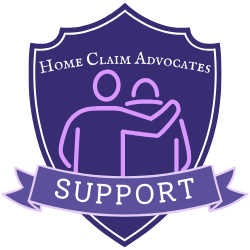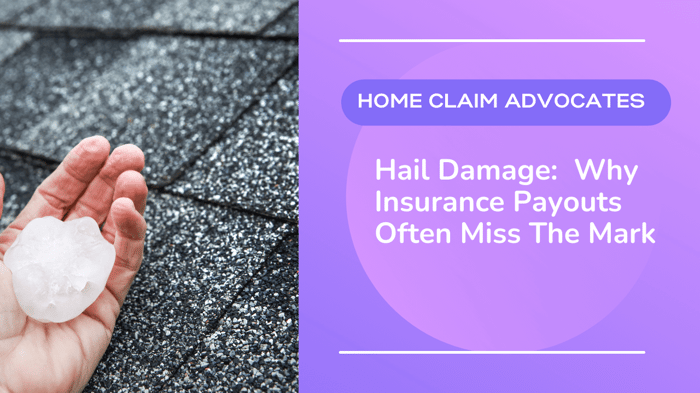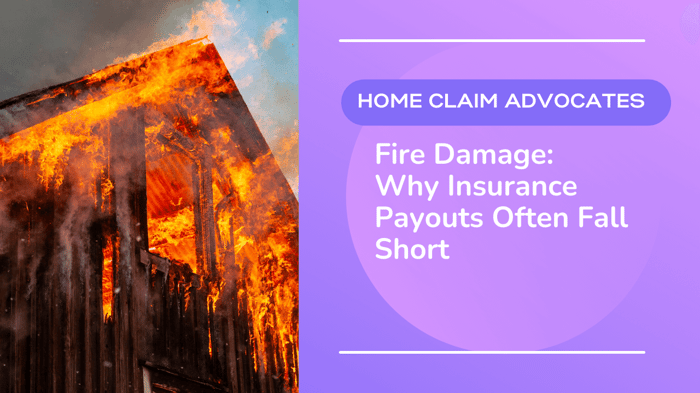Table of Contents
- What Is Hail Damage in a Homeowners Claim?
- The Hidden Costs of Hail Damage
- Why Do Insurance Companies Miss These Expenses?
- Understanding the Claim Process for Hail Damage
- The Role of a Public Adjuster in Hail Damage Claims
- Why Most Homeowners Don’t Realize They’re Underpaid
- Why a Free Policy Coverage Review Is Crucial
- Real-World Example
- Key Takeaways for Homeowners
- Conclusion
- FAQs
Hail Damage: Why Insurance Payouts Often Miss the Mark
Hailstorms can strike suddenly, leaving homeowners with dented roofs, damaged siding, and water leaks that aren’t always visible right away. While most homeowners know their policy covers hail damage, the settlement they receive often falls short of covering the true cost of repairs.
As public adjusters, we see this issue again and again: insurance companies underestimate the full scope of hail damage, and homeowners are left paying the difference. In this post, we’ll explain why this happens, what hidden costs are commonly missed, and why having a free policy coverage review from a public adjuster—like Home Claim Advocates, who do not sell insurance—is so valuable.
What Is Hail Damage in a Homeowners Claim?
Hail damage is more than just dents in shingles or broken windows. Depending on the size of the hailstones and the length of the storm, hail can compromise multiple parts of your property:
Roofing Systems – Shingles, flashing, underlayment, gutters, and vents.
Exterior Surfaces – Siding, stucco, brick, paint, windows, and screens.
HVAC Units – Outdoor air conditioning systems and ventilation equipment.
Vehicles and Outbuildings – Garages, sheds, and even fencing.
While some damage is immediately obvious—like shattered glass or visible dents—much of it is subtle and may not show up until months later. That’s where claims often fall short.
The Hidden Costs of Hail Damage
Insurance company adjusters typically focus on what they can see quickly. But hail often causes secondary or hidden damage that requires detailed inspection. Commonly missed expenses include:
Roof Seal Failures
Even if shingles aren’t broken, hail can weaken the adhesive seals, making the roof more vulnerable to leaks during the next storm.
Granule Loss
Hail impact removes protective granules from shingles. This shortens the roof’s lifespan, but insurers often dismiss it as “cosmetic.”
HVAC Efficiency
Dented fins on AC units reduce airflow, forcing the system to work harder and increasing energy costs. Replacement may be justified but is often excluded.
Interior Water Damage
Leaks caused by hail-weakened roofs might not appear for months. By then, insurers may argue the damage isn’t storm-related.
Code Upgrades
Local building codes may require updated materials or installation practices (like ice and water shield underlayment). Insurers sometimes omit these required upgrades from their estimates.
These overlooked costs mean homeowners end up paying out-of-pocket to restore their property to pre-loss condition—something the homeowners insurance policy should have covered.
Why Do Insurance Companies Miss These Expenses?
It’s not always intentional, but it is systemic. Here’s why:
Quick Inspections
Insurance adjusters often have limited time per claim, meaning they perform surface-level inspections rather than thorough evaluations.Standardized Pricing
Insurers use estimating software with generic pricing that may not reflect local contractor costs or current material prices.Incentive to Minimize
Remember: company adjusters work for the insurance company, not for you. Their role is to control costs, which means minimizing payouts wherever possible.Ambiguity in Coverage
Hail claims may trigger exclusions, depreciation calculations, or disputes over whether damage is “functional” or merely “cosmetic.” These gray areas often lead to reduced settlements.
Understanding the Claim Process for Hail Damage
Filing a hail damage claim isn’t always straightforward. Here’s a step-by-step breakdown of how it typically works—and where homeowners can get caught short:
Inspection by Insurance Adjuster
They conduct a brief walk-through, document obvious damage, and prepare a report.
Initial Estimate
Based on their report, you receive a settlement offer. This often underrepresents the true scope of damage.
Repairs Begin
Contractors may find additional issues (hidden leaks, code upgrades, material mismatches).
Supplemental Claims
You can request additional funds, but this often requires negotiations and more paperwork.
Disputes and Delays
Insurers may deny supplements or delay responses, leaving your repairs unfinished.
This is where a Licensed Public Adjuster (LPA) makes the difference.
The Role of a Public Adjuster in Hail Damage Claims
Unlike the insurance company’s adjuster, a public adjuster works exclusively for you, the homeowner. Here’s how we can help with hail damage:
Comprehensive Inspection
We don’t just look for visible dents or cracks. We evaluate the roof system, test for seal failures, assess HVAC efficiency, and check for hidden water intrusion.
Accurate Estimates
Our damage assessments are based on real-world contractor pricing and building code requirements, not just software averages of hail damage.
Policy Review
We thoroughly examine your insurance policy to ensure all potential benefits are applied—such as code upgrade coverage, ordinance and law provisions, or replacement cost terms.
Negotiation
We handle the back-and-forth with the insurance company, making sure supplements are approved and additional expenses are included.
Advocacy
From start to finish, our goal is simple: maximize your settlement so you can restore your home fully without paying out-of-pocket for covered losses.
Why Most Homeowners Don’t Realize They’re Underpaid
The reality is that many homeowners accept their first hail damage settlement without question. Why?
Trust in the Insurance Company – People assume the insurer is acting in their best interest.
Lack of Technical Knowledge – Roofing systems, code upgrades, and estimating software aren’t things most homeowners understand.
Stress and Fatigue – After a storm, families are overwhelmed. It feels easier to accept the check and move on.
Fear of Delays – Some worry that challenging the insurance company will prolong the process.
Unfortunately, this leaves thousands of dollars on the table. Studies show homeowners who use public adjusters receive significantly higher settlements than those who don’t.
Why a Free Policy Coverage Review Is Crucial
At Home Claim Advocates, we offer free policy coverage reviews to help homeowners understand their insurance better. Here’s why this matters, especially in hail-prone areas:
Unbiased Guidance
We do not sell insurance. Our only focus is ensuring you have the right coverage in place and understand how it applies when hail strikes.
Identifying Gaps
We can point out if your policy lacks ordinance-and-law coverage, has high deductibles, or excludes certain hail-related repairs. Knowing this now prevents costly surprises later.
Preparedness
A proactive strategy—understanding your policy before a storm hits—ensures you’re financially and mentally ready if you need to file a claim.
Real-World Example
Imagine a homeowner with a 15-year-old roof hit by hail. The insurance adjuster approves replacement of only a few shingles, citing “cosmetic damage.” But an independent inspection reveals seal failures across the roof, compromised underlayment, and local code requiring a full roof replacement.
The insurer’s initial offer: $6,000.
The actual cost of proper repair: $18,000.
Without advocacy, the homeowner would have paid $12,000 out-of-pocket. With a public adjuster, the claim is negotiated to cover the full replacement cost—saving the homeowner thousands.
Key Takeaways for Homeowners
Don’t accept the first offer without review.
Look beyond visible dents—hail damage often hides.
Know your policy before you need it.
Bring in professional help if something feels off.
Conclusion
Hailstorms are unpredictable, but your financial recovery shouldn’t be. Insurance payouts for hail damage often miss crucial expenses—whether it’s hidden leaks, reduced HVAC efficiency, or building code requirements.
A Licensed Public Adjuster ensures your claim is handled thoroughly, fairly, and in your best interest. At Home Claim Advocates, we provide free policy coverage reviews and expert claim assistance, so you’re never left paying out-of-pocket for damage your policy should cover.
Your home is more than a structure—it’s your sanctuary and one of your biggest investments. Don’t let hail damage compromise it. With the right guidance, you can navigate the claims process with confidence and ensure your property is fully restored.
FAQs
Does homeowners insurance cover hail damage?
Yes, most standard homeowners policies cover hail damage, but insurers often underestimate the full cost of repairs, leaving gaps you may need to contest.
Can I reopen my hail damage claim if I already accepted a payout?
Yes. In many cases, you can request a claim supplement or reopen a claim if new or hidden damage is discovered—especially within the first year after the storm. Through Home Claim Advocates’ Claim Settlement Double Check, you can have your payout reviewed at no cost. You won’t pay anything unless we succeed in getting you more money.
What types of hail damage are often missed by insurance adjusters?
Commonly missed issues include roof seal failures, shingle granule loss, HVAC efficiency loss, hidden leaks, and code-required upgrades.
Why do insurance companies underpay hail damage claims?
Adjusters work for the insurance company and focus on controlling costs. They use quick inspections and generic pricing tools that don’t always reflect actual repair costs.
How can a public adjuster help with my hail damage claim?
A public adjuster works for you, not the insurance company. They provide thorough inspections, accurate repair estimates, policy reviews, and negotiation to maximize your settlement.
What should I do right after a hailstorm?
Document all damage with photos and videos, save repair receipts, and schedule a professional inspection before filing a claim. Check out this article about understanding your duties in a homeowner claim for our top tips.
How long do I have to file a hail damage claim?
Deadlines vary by policy and state law, but typically range from 6 months to 1 year. Reviewing your policy or getting a free coverage review ensures you don’t miss deadlines.








